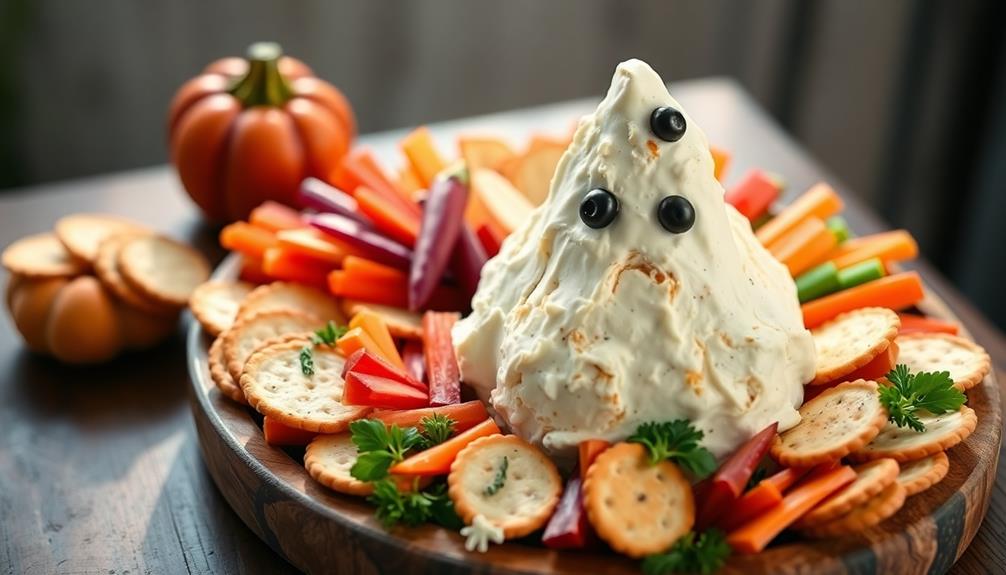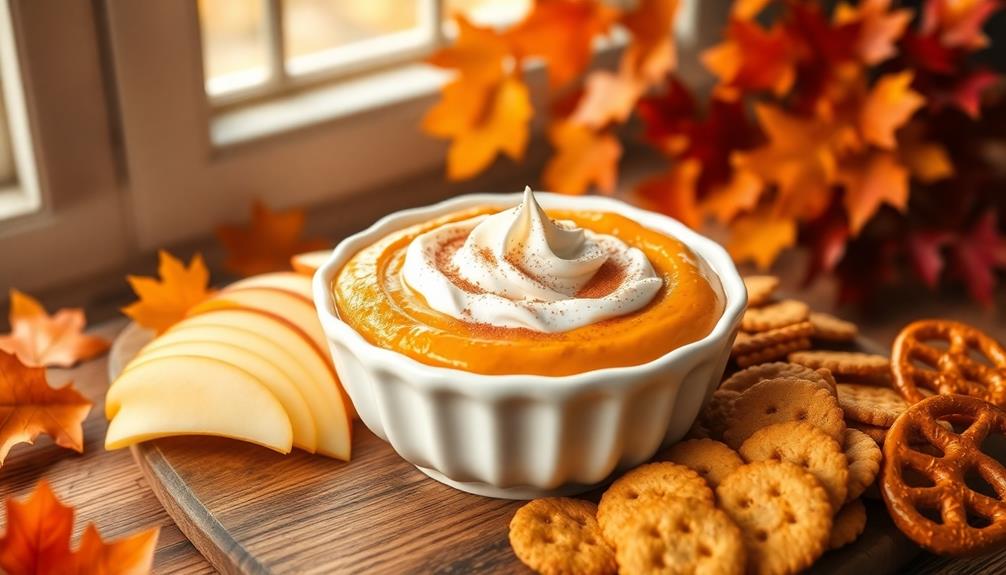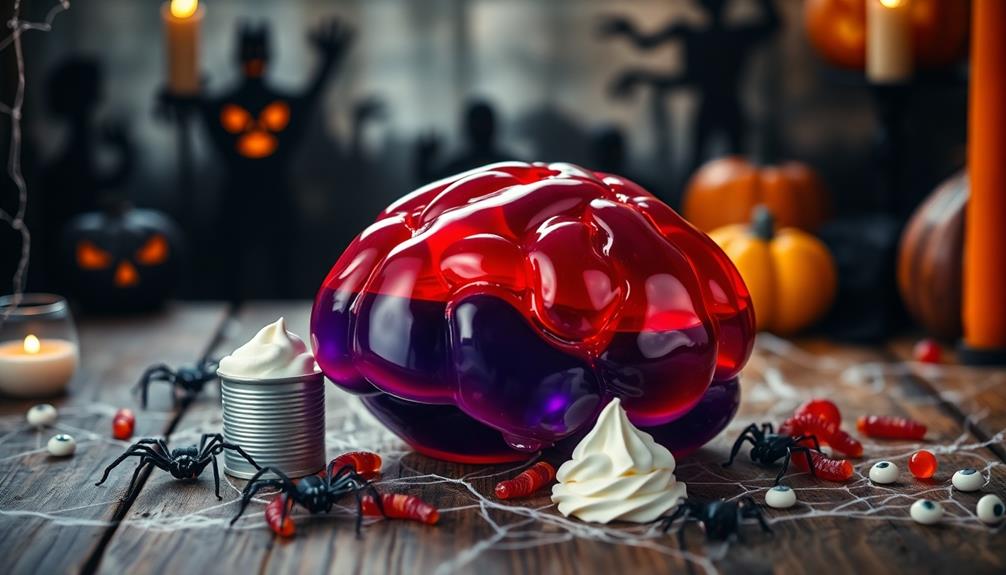The Ghostly Gouda Cheese Ball is a delightful appetizer perfect for Halloween celebrations. You'll start by softening cream cheese and blending it with Gouda, herbs, and spices. Shape the mixture into a ghostly figure, adding black olives for eyes and an edible tape mouth. Chill it for at least an hour to meld flavors and improve texture. When it's time to serve, present it surrounded by colorful veggies and festive crackers. This cheesy treat is sure to impress your guests, combining creamy textures with a playful design. Stick around, and you might discover more tips for your spooky gathering!
Key Takeaways
- The Ghostly Gouda Cheese Ball is a festive appetizer perfect for Halloween, featuring a blend of Gouda and cream cheese with herbs and spices.
- It is shaped to resemble a ghost, decorated with black olives for eyes and an edible mouth.
- Chill the cheese ball for at least one hour to enhance flavors and improve texture for serving.
- Serve with a variety of crackers, veggie sticks, or bread for an appealing presentation.
- Pair with drinks like sparkling cider or light beer to complement the spooky theme.
History
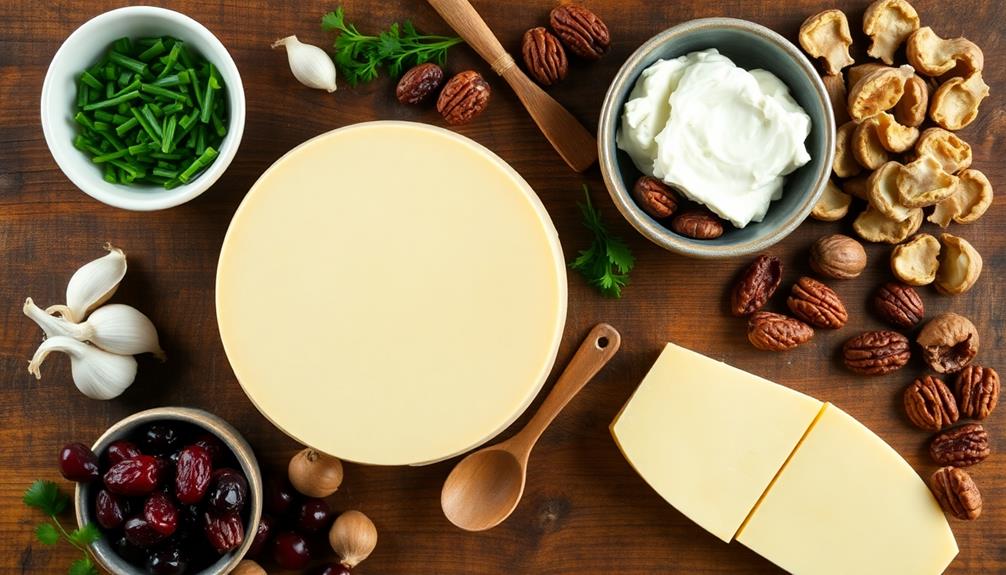
The origins of Gouda cheese date back to the Middle Ages in the Netherlands, where local farmers began crafting this rich and creamy delight.
You'll find that Gouda's name comes from the city of Gouda, a bustling trade hub. As trade flourished, so did the popularity of this cheese, thanks to its unique taste and smooth texture. Farmers used cow's milk, which was readily available, and perfected their techniques over generations.
As you explore Gouda's history, you'll notice that it was initially produced in small quantities, often made for local consumption.
However, by the 16th century, Gouda became an essential part of Dutch culture, with cheese markets emerging to sell it to a wider audience.
During the 18th and 19th centuries, Gouda cheese gained international acclaim, making its way to various countries.
Today, you can find countless varieties of Gouda, from young and mild to aged and robust. Each kind tells a story of tradition and craftsmanship.
Understanding this history not only enhances your appreciation for Gouda cheese but also connects you to a rich culinary legacy that continues to delight cheese lovers around the world.
Recipe
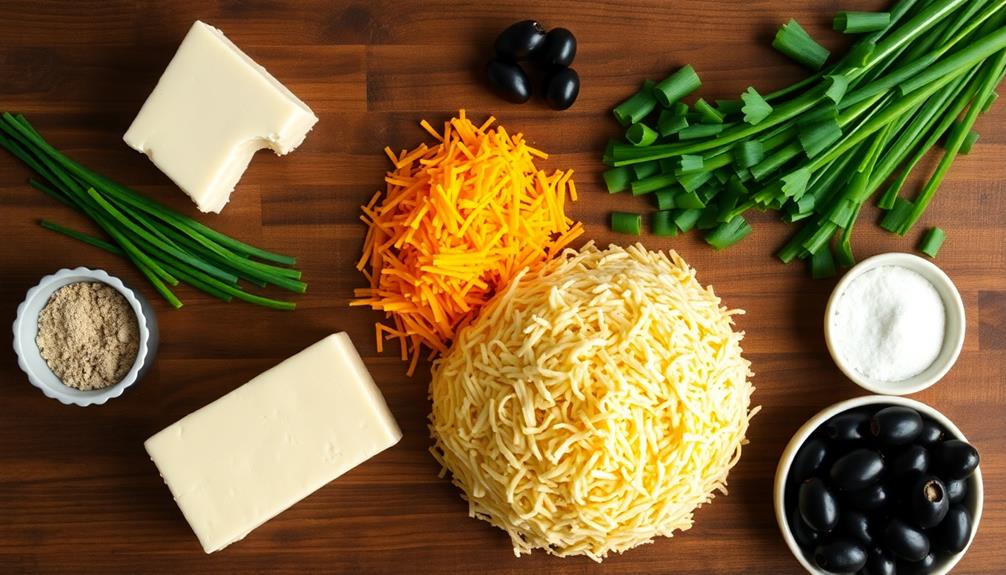
Ghostly Gouda Cheese Ball Recipe
The Ghostly Gouda Cheese Ball is a fun and festive appetizer perfect for Halloween gatherings or any spooky celebration. This creamy, flavorful cheese ball is easy to make and can be shaped into a ghostly figure that will impress your guests.
The combination of Gouda cheese and cream cheese creates a rich and savory filling, while the added herbs and spices enhance the taste, making it a delightful treat for any cheese lover. For a playful twist, consider pairing it with a sweet dessert like Dirt Cups that kids will love, ensuring your gathering is filled with both savory and sweet delights.
To give your cheese ball its ghostly appearance, you can use black olives for the eyes, adding a touch of whimsy to your presentation. Serve it alongside an assortment of crackers, veggie sticks, or bread for dipping, making it a versatile and crowd-pleasing snack.
This recipe is quick to prepare, and you can even make it a day ahead of time, allowing the flavors to meld beautifully overnight.
Ingredients
- 8 oz cream cheese, softened
- 8 oz Gouda cheese, shredded
- 1/2 cup shredded cheddar cheese
- 1/4 cup fresh chives, chopped
- 1/4 tsp garlic powder
- 1/4 tsp onion powder
- Salt and pepper, to taste
- Black olives, for decoration
- Optional: crackers and veggies for serving
Cooking Instructions
In a mixing bowl, combine the softened cream cheese, shredded Gouda, shredded cheddar, chopped chives, garlic powder, onion powder, salt, and pepper.
Mix until well combined and smooth. Shape the mixture into a ball and place it on a serving platter. Use your hands to mold it into a ghost shape, if desired, and chill in the refrigerator for at least an hour to firm up.
Before serving, use the black olives to create eyes on your cheese ball.
Extra Tips
To enhance the flavor of your Ghostly Gouda Cheese Ball, feel free to experiment with additional herbs or spices such as dill, paprika, or cayenne pepper.
You can also roll the cheese ball in crushed nuts or herbs for added texture and flavor. If you're short on time, you can skip the chilling step, but allowing it to sit in the fridge will help the flavors develop and make it easier to handle.
Enjoy your spooky creation with a side of festive fun!
Cooking Steps

To create your Ghostly Gouda Cheese Ball, you'll want to start by softening the cream cheese for easy mixing.
Once it's nice and creamy, add a generous amount of garlic powder and toss in some chopped herbs to boost the flavor. For a little sweetness, you can also drizzle in some honey or maple syrup. This creamy, garlic-infused sauce will take your dish to the next level. And if you’re looking for something sweet, why not try out this delicious strawberry smoothie recipe? It’s a refreshing and healthy treat that’s perfect for any time of day.
Shape your mixture into a ghost figure, then chill it before serving to let the flavors meld beautifully.
[DIRECTIONS]:Step 1. Soften Cream Cheese First
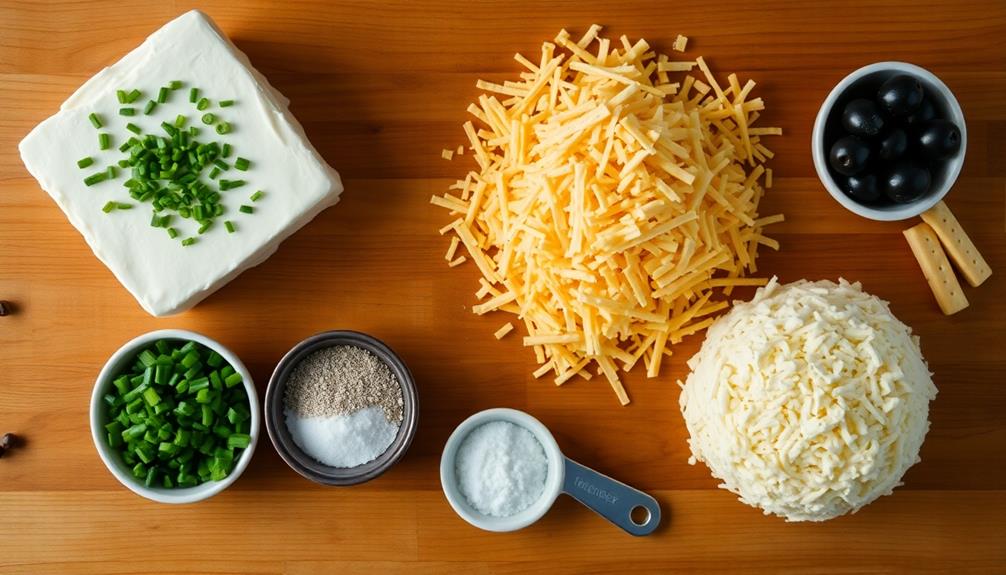
Soften your cream cheese before mixing it into the cheese ball for the best texture and flavor. Start by taking your cream cheese out of the refrigerator and letting it sit at room temperature for about 30 minutes. This step is crucial because cold cream cheese can be difficult to blend smoothly with other ingredients.
If you're short on time, you can cut the cream cheese into smaller cubes, which speeds up the softening process.
Once the cream cheese is softened, you'll notice it's much easier to work with. Grab a bowl and use a hand mixer or a sturdy spatula to blend it until it's creamy and smooth. This will ensure that your cheese ball has a delightful, spreadable consistency.
If you prefer a lighter texture, you can also microwave the cream cheese for about 10-15 seconds—just be careful not to overheat it, as you don't want it to become too runny.
With your cream cheese perfectly softened, you're ready to combine it with the other delicious ingredients in your ghostly gouda cheese ball. Enjoy the process, and get ready for an amazing treat!
Step 2. Add Garlic Powder Generously

Garlic powder adds a savory depth to your ghostly gouda cheese ball, making it a standout appetizer. When you're ready to incorporate it, grab your garlic powder and don't be shy—generously sprinkle it over your softened cream cheese and gouda mix.
The garlic will infuse the cheese ball with a bold flavor that perfectly complements the creamy texture. For an extra protein boost, consider serving it alongside some whole grain crackers or veggie sticks for a satisfying snack that fits into low carb high protein breakfast ideas.
Start with about a teaspoon of garlic powder, and remember, you can always adjust to your taste. Stir the mixture well, ensuring the garlic is evenly distributed throughout. This way, every bite bursts with that delightful garlicky goodness. If you love garlic as much as I do, consider adding a bit more.
As you mix, keep an eye out for any lumps; you want a smooth and cohesive mixture. The aroma should be tantalizing, hinting at the deliciousness to come.
Once you're satisfied with the flavor, you're one step closer to creating a memorable cheese ball that'll have everyone raving. So, roll up your sleeves, embrace the garlic, and let your ghostly gouda cheese ball shine at your next gathering!
Step 3. Mix in Chopped Herbs
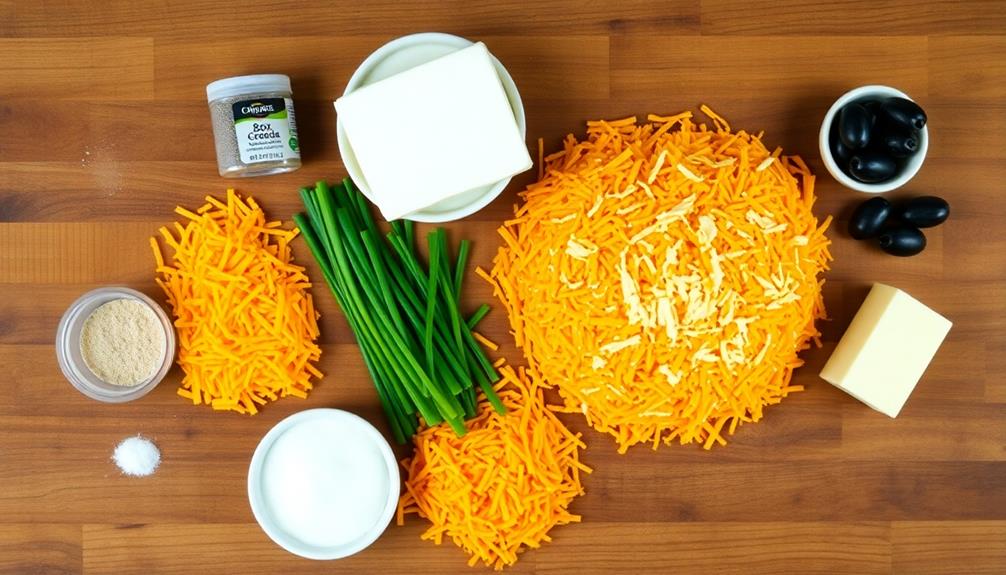
Now that your cheese mixture is infused with garlic goodness, it's time to elevate the flavor profile by mixing in chopped herbs. Fresh herbs not only enhance the taste but also add a lovely touch of color to your ghostly gouda cheese ball.
Start by choosing your favorite herbs; parsley, chives, and dill work beautifully. Additionally, incorporating herbs can provide health benefits as they're rich in antioxidants, which can help combat oxidative stress and promote overall well-being. Health benefits of honey can also complement the flavors in your cheese ball if you decide to serve it with a drizzle of honey.
Chop about two tablespoons of your selected herbs finely. You want them to blend seamlessly into the cheese, so make sure they're small enough to incorporate well.
Take your cheese mixture and gently fold in the chopped herbs using a spatula. Be careful not to over-mix; you want to maintain that creamy texture while ensuring the herbs are evenly distributed.
As you mix, you'll notice the aroma of the herbs mingling with the garlic, creating a delightful scent that'll make your taste buds tingle with anticipation.
Once you've achieved a good mix, taste a small amount. If you feel it needs more herbs, don't hesitate to add a bit more! This step allows you to customize the flavor to your liking, making your cheese ball uniquely yours.
Enjoy the process—this cheesy creation is already shaping up to be a hit!
Step 4. Shape Into a Ghost Figure
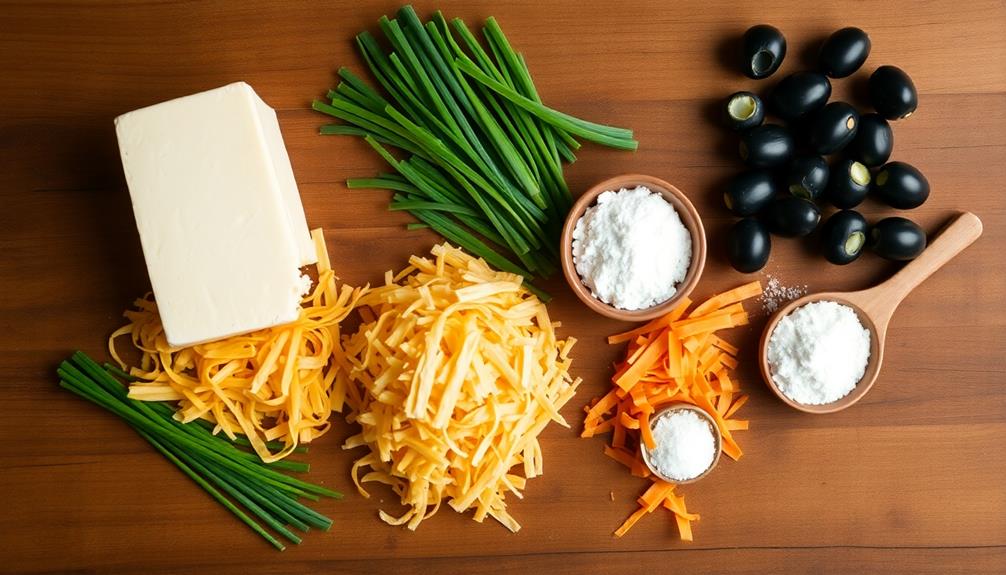
With your herb-infused cheese mixture ready, it's time to bring your ghostly gouda cheese ball to life by shaping it into a spooky ghost figure.
Start by taking a generous portion of the cheese mixture, about the size of a large orange. Roll it gently between your hands to form a smooth ball. This will be the base of your ghost.
Next, flatten the top slightly to give it a ghostly head.
Now, for the fun part—create a flowing ghostly body! Using your hands, gently elongate the bottom half of the ball, letting it taper downwards, resembling a ghostly sheet. Don't worry about making it perfect; a little unevenness adds character.
Once you're satisfied with the shape, use two small pieces of black olives or peppercorns for the ghost's eyes. Press them gently into the cheese to create a haunting expression.
For a whimsical touch, you can use a piece of edible black tape or a thin slice of cheese to make a mouth.
Step 5. Chill Before Serving
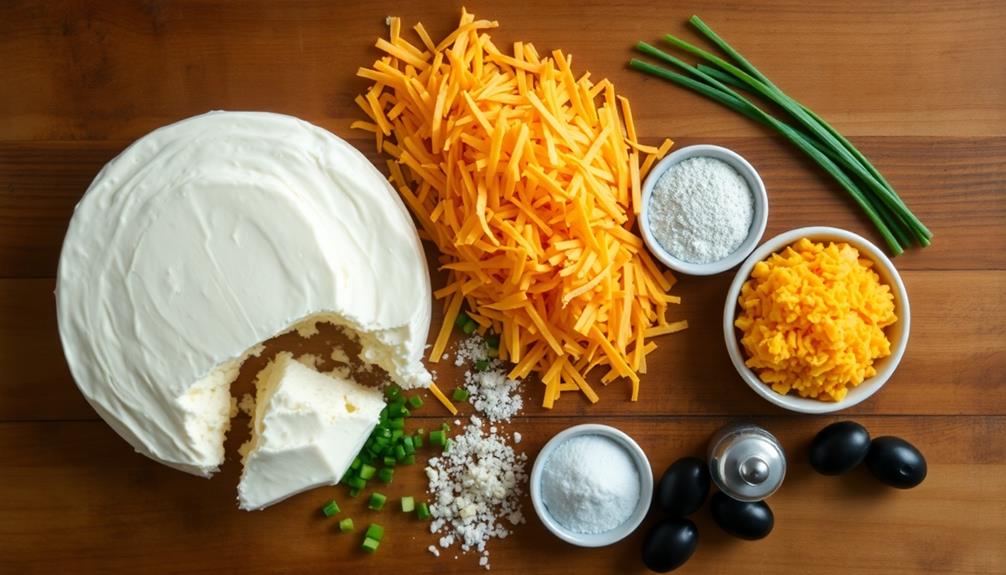
After crafting your ghost figure, it's important to let your gouda cheese ball chill in the refrigerator for at least an hour.
This chilling time isn't just for aesthetics; it allows the flavors to meld beautifully, enhancing the overall taste. The cool environment helps the cheese ball firm up, making it easier to slice or spread later.
While your cheese ball chills, you can prepare your serving platter.
Consider adding some fun Halloween-themed crackers or fresh veggies to accompany your ghostly creation. Not only will this add color, but it'll also give your guests a variety of options to enjoy with the cheese.
Once your hour's up, check on your gouda ghost.
It should feel firmer to the touch and have a delightful aroma. If you want to amp up the spooky factor, you can use sliced olives or peppercorns to create eyes and a mouth right before serving.
Final Thoughts
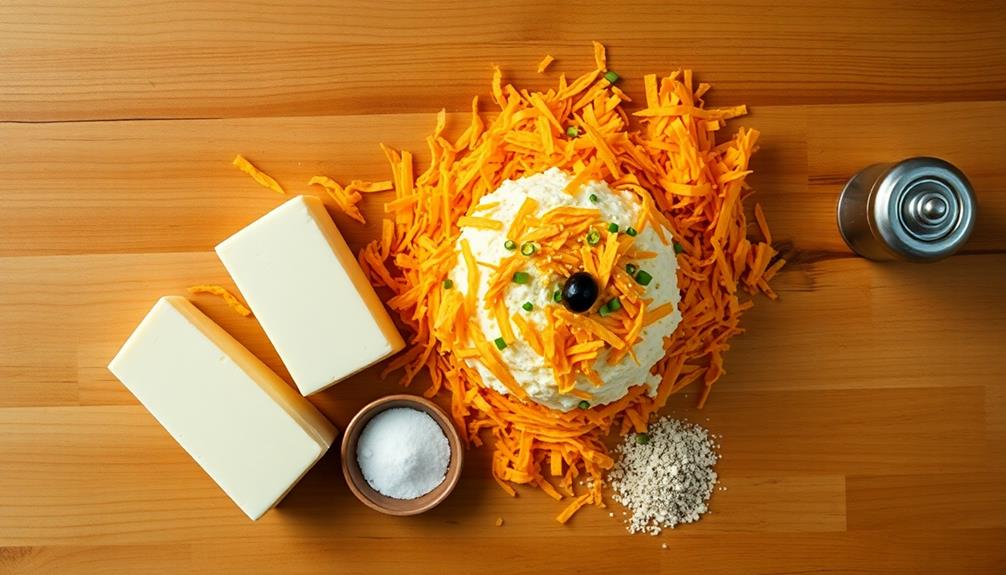
As you wrap up your spooky soiree, the Ghostly Gouda Cheese Ball is sure to be a hit. Its creamy texture and delightful flavors will leave your guests raving about your culinary skills.
For those planning a family getaway, consider pairing your gathering with a visit to hotels featuring top hotels with water parks, adding an extra layer of fun to your celebrations.
Remember, presentation is key! Serve the cheese ball on a festive platter surrounded by colorful veggies, crackers, or even ghost-shaped cookies to enhance the Halloween spirit.
Don't forget to pair it with a selection of drinks. A crisp white wine or a light beer complements the richness of the Gouda perfectly. If you're looking for a fun non-alcoholic option, consider a sparkling cider—it adds a festive touch without the booze.
As you enjoy the festivities, take a moment to appreciate the effort you put into creating this delicious treat. Your guests will certainly enjoy the deliciousness, but they'll also admire your creativity.
Frequently Asked Questions
Can I Use Low-Fat Cheese for This Cheese Ball?
You can definitely use low-fat cheese for your cheese ball! Just keep in mind that it might alter the texture and flavor slightly, but you'll still end up with a tasty treat everyone will enjoy.
How Long Can I Store the Ghostly Gouda Cheese Ball?
You can store the cheese ball in the fridge for about a week. Just make sure it's wrapped tightly to keep it fresh. If you freeze it, it'll last up to three months. Enjoy!
What Are Some Good Dipping Options for the Cheese Ball?
You'll love pairing your cheese ball with crunchy crackers, fresh vegetable sticks, or soft pretzels. For something different, try apple slices or breadsticks. These options enhance the flavors and make your cheese ball experience even better!
Can I Freeze the Cheese Ball for Later Use?
Yes, you can freeze the cheese ball for later use. Just wrap it tightly in plastic wrap and place it in an airtight container. When you're ready, thaw it in the fridge before serving.
Is This Recipe Suitable for Vegetarians?
Yes, this recipe's suitable for vegetarians if it uses plant-based ingredients. Check for any non-vegetarian components, like certain cheeses or additives, to ensure it aligns with your dietary preferences. Enjoy your delicious creation!
